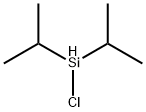A2580612
Chlorodiisopropylsilane , >95.0%(GC) , 2227-29-4
Synonym(s):
Diisopropylchlorosilane
| Pack Size | Price | Stock | Quantity |
| 5ML | RMB315.20 | In Stock |
|
| 25ML | RMB1175.20 | In Stock |
|
| others | Enquire |
Update time: 2022-07-08
PRODUCT Properties
| Boiling point: | 58-60 °C50 mm Hg(lit.) |
| Density | 0.883 g/mL at 25 °C(lit.) |
| refractive index | n |
| Flash point: | 72 °F |
| storage temp. | Inert atmosphere,Room Temperature |
| solubility | generally sol organic solvents; reacts with alcohols,
ammonia,and water. |
| form | clear liquid |
| color | Colorless to Almost colorless |
| Specific Gravity | 0.883 |
| Hydrolytic Sensitivity | 8: reacts rapidly with moisture, water, protic solvents |
| BRN | 2231355 |
| InChI | InChI=1S/C6H15ClSi/c1-5(2)8(7)6(3)4/h5-6,8H,1-4H3 |
| InChIKey | CGXYLRTYLIHXEE-UHFFFAOYSA-N |
| SMILES | [SiH](Cl)(C(C)C)C(C)C |
| CAS DataBase Reference | 2227-29-4(CAS DataBase Reference) |
| EPA Substance Registry System | Silane, chlorobis(1-methylethyl)- (2227-29-4) |
Description and Uses
Intramolecular hydrosilylation is also possible within β-diisopropylsilyloxy esters (13), constituting an exceptionally mild method for reducing ester groups to the aldehyde oxidation level (eq 4).The derivatives (13) may be synthesized from β-hydroxy esters (12) as described above for the analogous ketones. Treatment with fluoride ions (but not Lewis acids) induces hydride transfer to give alkoxysiladioxanes (14) in excellent yields (≥95%). Although usually performed in dichloromethane, the hydrosilylation may also be accomplished with ethyl acetate as solvent, providing strong evidence for intramolecularity.
Safety
| Symbol(GHS) |   GHS02,GHS05 |
| Signal word | Danger |
| Hazard statements | H226-H314 |
| Precautionary statements | P210-P233-P240-P280-P303+P361+P353-P305+P351+P338 |
| Hazard Codes | C |
| Risk Statements | 10-34 |
| Safety Statements | 26-36/37/39-45 |
| RIDADR | UN 2986 8/PG 2 |
| WGK Germany | 3 |
| F | 10-21 |
| TSCA | Yes |
| HazardClass | 3.1 |
| PackingGroup | II |
| HS Code | 29319090 |
| Excepted Quantities | Not Permitted as Excepted Quantity |


